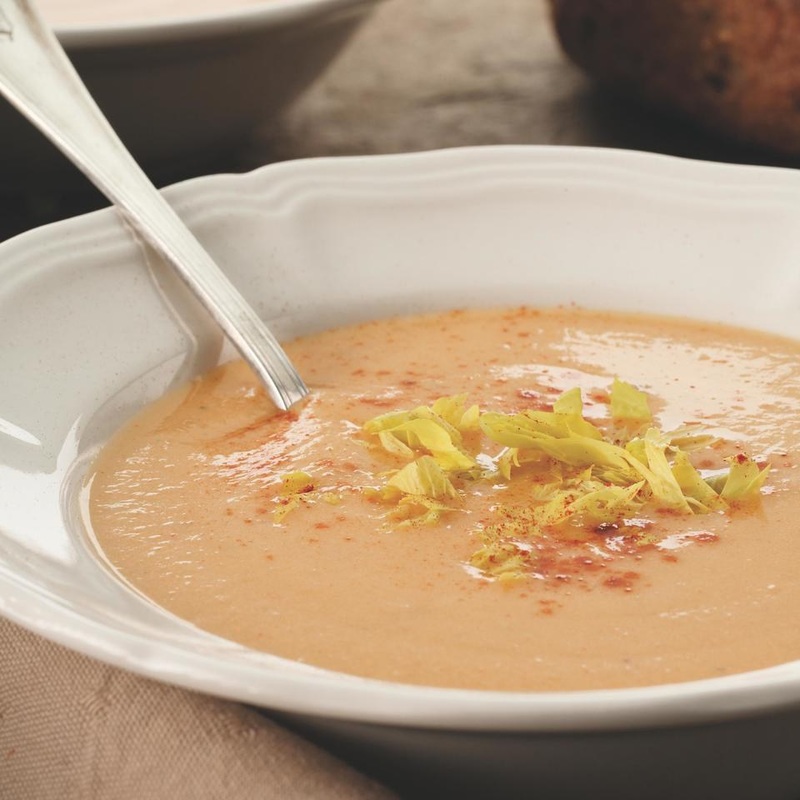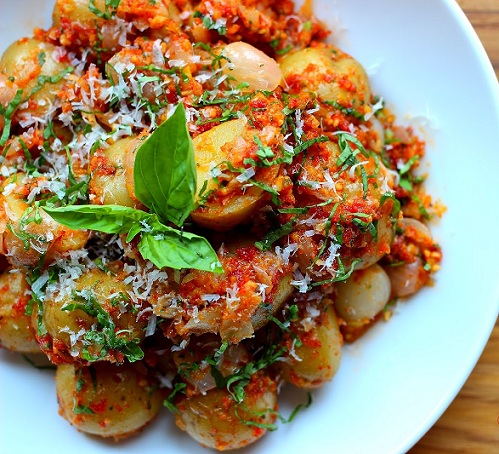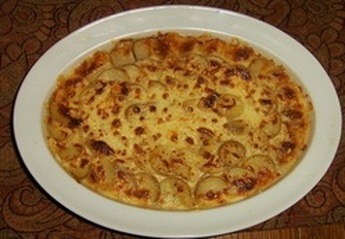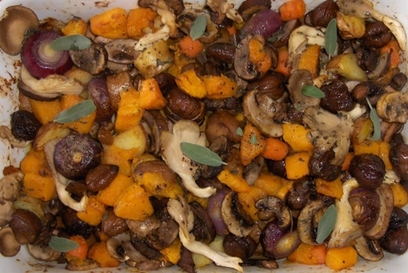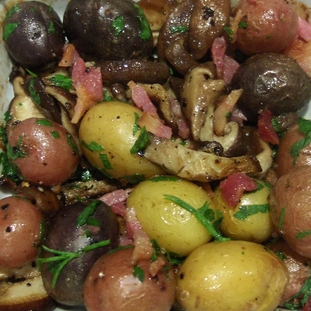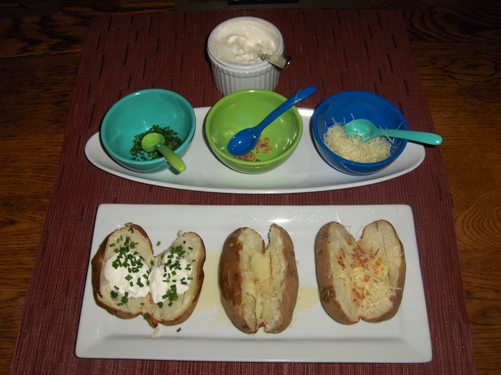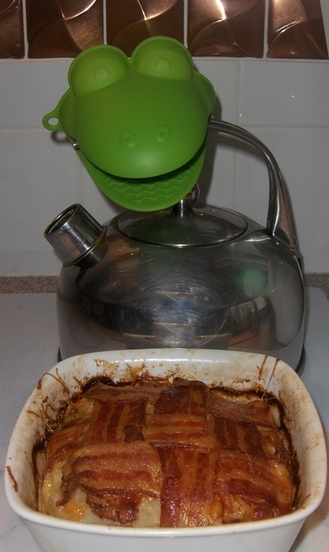|
Ingredients
Directions 1. Heat oil in a medium saucepan over medium heat. Add apple, potato, onion and celery; cook, stirring often, until the onion is translucent, about 5 minutes. 2. Stir in salt, sage, paprika and pepper; cook for 30 seconds. 3. Pour in broth and bring to a simmer. Reduce heat, cover, and gently simmer until the potato is tender when pierced with a fork, 10 to 15 minutes. 4. Use an immersion blender or transfer the soup to a large blender or food processor add sour cream (if using) and process until smooth. 5. Garnish with celery leaves, if desired.
0 Comments
INGREDIENTS For the Salad: 3 pounds baby red potatoes 2 cups shredded carrots 2 cups celery, chopped 1 large sweet onion, diced (substitute red onion if you want a bite to the salad) Optional: 2 cups arugula or baby spinach For the Dressing: 1 cup prepared hummus 1/4 prepared pesto 1 Tbsp lemon juice PREPARATION Cut the potatoes into 1-inch cubes. Place in a large stockpot and cover with water. Bring to a boil, then reduce heat and let simmer until potatoes are tender (you should be able to pierce them with a fork). Drain and let cool. In a large bowl, combine the potatoes with the remaining salad ingredients, mixing well to combine. Whisk together dressing ingredients in a bowl. If too thick, add a little water. Pour the dressing over the salad. Toss gently to coat. Serve chilled. Serves: 6 to 8 3½ - 4 lbs. Yukon Gold potatoes, unpeeled, cut into ? inch slices 5 tablespoons of softened butter, divided 2 large shallots, minced 1 cup cream 1 cup whole milk ½ teaspoon salt ½ teaspoon fresh black pepper 1 teaspoon Dijon mustard 1½ cups freshly grated artisanal Cheddar Cheese 1. Preheat the oven to 375º. 2. Generously grease a large casserole dish or baking pan with 2 tablespoons of the softened butter. 3. Melt the remaining 3 tablespoons of butter in a large sautè pan. Add the minced shallots and cook until the shallots are translucent. 4. Add the salt and pepper, mix well. Remove the pan from the heat. 5. Slowly add ½ of the cream while stirring. When the butter, shallot and cream have been well blended, add the remaining cream and mustard. Repeat the blending process. 6. Return the pan to a low heat. Continuing to stir, add the milk slowly. Allow the mixture to thicken a bit, then remove the pan from the heat. 7. Arrange the potato slices in a circular or oval process until the bottom of the casserole dish is covered. 8. Distribute a couple of large spoonfuls of the shallot cream mixture over the potato layer. Sprinkle generously with the grated cheddar. 9. Repeat the layers until all the preparations have been distributed in the casserole dish. 10.Cover the dish with aluminum foil and crimp the foil around the edges. 11.Slide the casserole into the heated oven and cook for about 40 minutes until the potatoes are tender and offer no resistance to a toothpick. Recipe by Anna Gill
2 pounds marble or fingerling blue potatoes, washed but unpeeled 1 medium shallot, thinly sliced ¼ cup extra-virgin olive oil ¼ cup dry white wine 4 sprigs thyme 1 large garlic cloves, pressed through a garlic press Kosher or sea salt 1. Preheat the oven to 350°. 2. In a small roasting pan, toss the potatoes with the shallot, olive oil, wine, thyme sprigs and garlic and season with salt. 3. Cover with foil and bake for about 15 to 20 minutes, or until just tender. 4. Uncover, stir well and bake for 5 to 10 minutes longer, or until the potatoes are very tender and lightly glazed. 5. Season with salt and serve. Recipe by Kay Carroll, adapted from Eating Well magazine
8 servings • 1 tablespoon extra-virgin olive oil • 10 ounces turkey Italian sausage, halved and sliced or crumbled • 1 cup chopped onion • 1 cup chopped carrot • 2 tablespoons miinced garlic • 6 cups low-sodium chicken broth or stock • 1 14-ounce can diced tomatoes, or fresh equivalent • 1 tablespoon chopped fresh marjoram or thyme • 1 pound boiling potatoes, cubed • 1 pound , stems removed and chopped • 1 15-ounce can kidney beans, rinsed (or dried and cooked equivalent) • Salt and –pepper to taste 1. Heat oil in a large pot over medium heat. Add sausage and cook, stirring often, until lightly browned, 4 to 5 minutes. Transfer the sausage to a plate. 2. Add onion and carrot to the pot; cover and cook, stirring occasionally, until soft, 5 to 10 minutes. 3. Stir in garlic and cook 1 minute more. 4. Add broth (or stock), tomatoes with their juice and marjoram (or thyme). Cover and bring to a boil. 5. Add potatoes, reduce heat and simmer, uncovered, for 10 minutes. 6. Stir in the reserved sausage, kale and beans. Return to a simmer and cook, stirring often, until the potatoes are tender, 4 to 5 minutes more. 7. Season with salt and pepper and serve. Recipe by Anna Gill
Serves: 8 6 to 8 small heirloom red potatoes (best if red inside and out) 6 to 8 small heirloom blue potatoes (best if blue inside and out) 10 to 15 small heirloom carrots of mixed colors 6 to 8 shallots, peeled and trimmed ¼ to ½ cup of good green olive oil 2 tablespoons freshly ground pepper ½ teaspoon salt 4 to 6 sprigs of thyme 1. Preheat the oven to 350 degrees F. 2. Clean the vegetables without removing their skins. Cut as require to make the pieces reasonably the same size. 3. Mix the oil, salt and pepper and drizzle it over the vegetables. Top with thyme sprigs. 4. Roast in the oven until tender throughout when pierced with a fork. Toss occasionally durning the process to re-distribute the seasoning. Recipe by Kay Carroll
Serves 6 6 medium to large potatoes 1 large onion, sliced 1 cup sliced carrots 1 cup chopped celery 2 Tablespoons minced garlic 1 Tablespoon olive oil 1 lb. ground meat (your choice: beef, bison, chicken, turkey) 3 cups chopped or crushed cooked tomatoes Peppercorns Salt Vegetable or beef broth/bouillon (optional) 1. Wash potatoes and remove/cut out any bad spots. Then peel the potatoes and cut into 1 inch cubes. Reserve the peels. 2. In a large soup pot, cook the potato cubes in 6 cups of water. Bring to a boil and cook for 10 minutes, or until potatoes are soft but still firm. Once cooked, drain and save liquid for soup. Let potato cubes cool. 3. Cut the potato peels into small pieces. 4. To the reserved potato liquid add enough water to equal 8 cups of liquid. Add the chopped potato peels, onion, carrot, celery and garlic. Add peppercorns and salt to taste. Bring to a boil and then reduce to a simmer. Cook at a simmer, covered, until vegetables are tender, about 45 minutes. 5. In a frying pan, heat the olive oil then sauté the ground meat until just cooked. Set aside. 6. Once the vegetables are cooked, add the reserved cubed potatoes, ground meat and tomatoes. Stir and cook until heated through, 5 – 10 minutes. 7. Taste the soup and decide if you want to add broth or bouillon for flavor. 8. Serve with croutons or bread to dip. Recipe by Originally published as Maine Potato Candy in Taste of Home April/May 2000, p65
Yield: 2 pounds Servings: 36 4 cups confectioners' sugar 4 cups flaked coconut 3/4 cup cold mashed potatoes (without added milk and butter) 1-1/2 teaspoons vanilla extract 1/2 teaspoon salt 1 pound dark chocolate candy coating, coarsely chopped 1. In a large bowl, combine the first five ingredients. 2. Line a 9-in. square pan with foil; butter the foil. 3. Spread coconut mixture into pan. Cover and chill overnight. Cut into 2-in. x 1-in. rectangles. Cover and freeze. 4. In a microwave, melt candy coating; stir until smooth. 5. Dip bars in coating; allow excess to drip off. Place on waxed paper to set. Store in an airtight container. Recipe by Anna Gill
Serves: 4 as a main course 2 tablespoons extra lite olive oil 2 cloves of garlic, pressed 1 large leek, cleaned, trimmed and thinly slices 6 to 8 leaves of sage, minced, plus another 5 for garnish ½ teaspoon fresh thyme leaves 2 tablespoons tomato paste 1 to 2 cups of vegetable broth 10 to 12 small red cipollini onions, paper and ends removed and kept whole 1 -14.8 oz. jar roasted, peeled whole chestnuts 2 cups butternut squash in 2 inch cubes 5 to 7 fingerling potatoes, washed and chunked, (approximately 2 inch pieces) 2 carrots, washed and chunked, (approximately 2 inch pieces) 2½ cups oyster mushroom, torn into 1½ inch florets 2 cups baby Portobello or white button mushrooms, sliced thickly Salt & freshly ground pepper 1. Preheat oven to 375o. 2. Heat the olive oil in a medium sized saucepan. 3. Add the garlic and leeks and sauté until the leeks are wilted and slightly translucent. 4. Add the minced sage, thyme leaves and the tomato paste. Stir and cook gently for about 2 minutes. 5. Remove the vegetables and herbs with a slotted spoon to a bowl, leaving as much of the cooking fluid as possible. Set the vegetables aside. 6. Coat the bottom of a 14 inch baking pan with the reserved liquid and add ¼ cup of the vegetable broth. Add the cipollini, squash and the chestnuts to the baking dish and place in the oven for about 15 minutes. 7. Add the potatoes, carrots and both types of mushrooms to the baking dish and sprinkle the reserved sautéed vegetables over them. Add a ¼ cup of vegetable broth as needed. (While this dish needs the broth, like risotto, it should added in small quantities, a little at a time.) Toss all the vegetables together and return the baking dish in the oven. 8. Lower the temperature to 350o and cook for approximately 20 to 30 minutes, adding broth as it is absorbed. When ready, the vegetables should be easily pierced but should not crumble. 9. Remove the baking dish, season with salt and pepper, garnish with the remaining sage leaves and serve. VARIATIONS: Depending on the season there are an infinite number of alternative vegetables that can be used here. The trick is to give the denser veggies, like the whole cipollini and the chestnuts a longer cooking time than those that cook more quickly. Recipe by Anna Gill
QUANTITIES: Allow per adult: 1 small (1 pound) lobster 1 ear of fresh shucked corn 2 to 3 new potatoes 6 to 12 Little Neck clams 3 to 4 tablespoons of melted butter 1 lemon, cut into wedges If you are using other options such as sausage, onion, mussels, shrimp or chicken, adjust the amounts accordingly. PIT CLAMBAKE: • Have the pit dug either early in the morning or the previous day. • Have a sufficient number of reasonably flat stones chosen, sea-washed, dried and ready. • Have a canvas tarp large enough for your pit opening. Soak it in seawater for at least an few hours (canvas does not easily absorb the water) but overnight soaking is better if possible. • Either have plenty of charcoal available, or enough driftwood, time and patience if you wish to be “authentic”. • Gather enough seaweed for the number of layers you will need. It is best to keep the seaweed in a net in the water until it is needed. If seaweed is not available, there are stores that carry frozen seaweed. Alternatively, you can use layers of corn husks or large leaf lettuce, like Romaine. • Light your charcoal at least two hours before you begin to add your layers of food. If you have chosen the driftwood method, it will have to have burned to glowing coals two hours before the food layering. • You may wish, for the sake of convenience, to add a layer of cheesecloth or netting under each layer of food. It will allow you to remove the food groups all at once in an easier fashion that one piece at a time. • The food items that require the longest cooking time, such as potatoes, go into the initial layer, decreasing as the layers rise and the cooking time is reduced. The clams and corn should be at the top. • If you have heated your stone lining sufficiently, you will need approximately 20 minutes of cooking time after the tarp has been placed over the food filled pit. • Have plenty of potholders, oven mitts and long handled forks available for the bake masters. • Have plenty of napkins and a tub of soapy water available for the diners. They will also need picking forks and lobster or nutcrackers to extract the lobster meat. Long toothpicks can stand in for the picking forks and in a pinch, don’t forget pliers and vises. PITLESS CLAMBAKES: • Have a stable charcoal grill large enough to accommodate your steamer. The actual coals can be fired on the ground in a campfire arrangement and topped with a footed iron grill surface. What is critical is its stability. • Choose your steamer according to the number of people you intend to feed. You may also use a clean, water-tight, metal garbage can, or any large metal canister with a flat bottom and a cover. • Add two inches of salted water to your steamer. • If you are using a metal container designed for another purpose, you will need to add a grate on the inside to raise your food levels above the water level. Depending on the size of your container, a two inch high cake rack can be helpful. Some recommend the use of upended tin cans that have had their tops and bottoms removed to support the layering. • You may wish, for the sake of convenience, to add a layer of cheesecloth or netting under each layer of food. It will allow you to remove the food all at once in an easier fashion that one piece at a time. • The food items that require the longest cooking time go into the initial layer, decreasing as the layers rise and the cooking time is reduced. The potatoes should be in the bottom layer and clams and corn should be at the top. • While the layering sequence is the same as a pit clambake, the timing could be exceedingly different, depending on the amount of heat your fire can generate. The best clue is when your clams are fully open. • Have plenty of potholders, oven mitts and long handled forks available for the bake masters. • Have plenty of napkins and a tub of soapy water available for the diners. They will also need picking forks and lobster or nutcrackers to extract the lobster meat. Long toothpicks can stand in for the picking forks and in a pinch, don’t forget pliers and vises. Recipe by Anna Gill
Serves: 8 2 lbs. whole marble potatoes, washed 1 lb. shitake mushrooms, wiped and cut into 2 inch pieces 2 tablespoons extra-virgin olive oil 2 tablespoons butter 2 garlic cloves, minced 4 sliced thick bacon, cooked crisp and diced ½ cup minced parsley Sea salt and freshly ground pepper 1. Pre heat oven to 350 degrees. 2. In a large bowl, toss potatoes, mushrooms, oil, butter and garlic. Let sit for an hour. 3. Place potato and mushroom mixture in a ceramic baking dish. 4. Roast in oven for approximately 30 minutes, turning once. 5. Remove baking dish from the oven. Season lightly with the salt and pepper 6. Sprinkle with the parsley and bacon bits, toss gently and serve in the baking dish. Recipe by Jane Elder Rowell
Serves: 6 to 8 6 large new potatoes, peeled and cut lengthwise 2 hardboiled eggs, cooled, peeled and finely mashed with a fork 4 celery stalks, washed and diced ½ medium onion ⅓ cup pickle juice ½ cup mayonnaise salt and pepper to taste ¼ to ⅓ cup minced fresh parsley 1. Place the potatoes in a large pot and cover them with cold water. Bring the water to a boil, reduce to a simmer and cook until the potatoes are thoroughly cooked but can maintain their shape. Drain and set aside to cool. 2. Using a box grater, grate the onion into a bowl, capturing all the “gratings” as well as the juice. 3. When the potatoes have cooled down enough to handle them easily, cut them into bite-sized cubes and place them in a large separate bowl. 4.Add the mayonnaise, mashed eggs, pickle juice and parsley to the bowl of grated onion and mix thoroughly. Season the sauce with salt and pepper. 5. Add the celery to the bowl of potatoes. 6. Add the sauce to the bowl of potatoes and celery. Using a large spatula, fold the ingredients together gently enough not to break the potatoes apart. 7. Cover and store the potato salad in the refrigerator for 6 to 12 hours before serving if possible. Recipe by Anna Gill
2 pounds blue-fleshed potatoes (unpeeled) 1 cup whole milk ¼ cup (½ stick) butter Sea salt Place potatoes in large saucepan; cover with cold water. Bring to boil, reduce heat to medium, and simmer until tender, about 15 to 20 minutes, depending on the size. Drain well; cool slightly. Peel and mash potatoes; place in large saucepan. Over medium heat, dry out potatoes for 2 minutes, stirring occasionally. Meanwhile, heat milk in small saucepan until warm. Stir butter into potatoes. Add warm milk and stir until completely absorbed. Season with sea salt. Recipe by Anna Gill
Serves: 4 There may be as many potential toppings for baked potatoes as there are potato varieties. My personal favorite is the classic sour cream and chive combination. But it is being marginalized lately by the blend of bacon bits and Fontina cheese. On the other hand, those crispy fried shallots are pretty close to perfection. The real point is that the topping permutations are nearly endless. A few short years ago, no one would have believed that there would be kale chips to crumble. So once again the message is to play with your food. It’s fun. Potatoes 4 large baking potatoes, thoroughly washed with a brush Kosher salt Aluminum foil Toppings Unsalted butter Sour cream Grated Swiss, gruyere, cheddar, Monterey Jack, Fontina or blue cheese Minced chives, thinly sliced scallions or grated sweet onion Fried shallots Chopped bacon Crumbled potato or kale chips Crumbled gingersnaps Finely shredded parsley Salsa Wilted spinach 1. Preheat oven to 350°F. 2. Place one oven rack on the lowest level and place a sheet of aluminum foil on it to catch any drippings. Place another rack higher but still in the lower third or half of the oven. 3. Pat the potatoes dry with paper towels. 4. Using a sharp fork, poke a few holes in the potato skins and sprinkle lightly with the Kosher salt. 5. Bake approximately 1 to 1¼ hours, until the skin is crisp but a toothpick inserted into the middle will meet with no resistance. 6. Make a lengthwise slit in each potato and serve with the toppings of choice Recipe by Anna Gill
Serves: 4 to 5 Unsalted butter for pan 2 large potatoes, peeled and sliced thin Salt and freshly ground black pepper 6 thin slices slab bacon, about 6 ounces 8 ounces Gruyere cheese, shredded. 1. Preheat oven to 425 degrees. 2. Lightly butter a 6 inch oven proof dish. 3. Pat potatoes dry on paper towels, place in a bowl and season with salt and pepper. 4. Line the buttered dish with bacon slices. The shape of the dish can determine the way you lay in the bacon. If it is square dish you can make a lattice work like a pie crust (allowing the edges to hang over the top). If the dish is round, you can arrange the bacon like a pinwheel across the bottom (allowing the edges to hang over the edge). Or you can forget the design and simply line the bottom of the dish leaving enough of the slice left hanging over the edge to cover the top when the layering is complete. 5. Arrange one-half of potatoes in pan in an even layer. 6. Top with half the cheese. Add the remaining half of the potatoes, then the rest of the cheese, then the rest of the potatoes. 7. Fold overhanging bacon strips back over top in whatever design you wish. 8. Place on lowest rack in oven and bake for approximately 45 minutes, until potatoes offer no resistance when pierced with point of a sharp knife. 9. Use a spatula to compress cake a few times during baking. 10. Cool cake on a rack for a few minutes. Place serving plate over cake and invert. 11. Serve in slices or wedges as suits the chosen shape. Recipe by Anna Gill
Serves: 6 to 8 3 pounds medium white turnips, peeled and quartered 3 pounds Idaho potatoes, peeled and quartered Salt 1 stick unsalted butter; cut into tablespoons 1 cup milk Freshly ground white pepper ¼ cup fresh flat-leaf parsley leaves 1. In a large saucepan, cover the potatoes with water and bring to a boil over high heat. Stir in 2 teaspoons of salt and boil for 5 minutes. 2. Add the turnips and boil until the potatoes and turnips are tender when pierced, about 15 minutes. Drain in a colander. 3. Return the potatoes and turnips to the saucepan and, using a potato masher or a large spoon, mash with the butter and milk. Season with salt and white pepper. 4. Transfer the mashed vegetables to a large, shallow, heat-proof serving dish. 5. Decorate the border with the parsley and serve. NOTE: This dish can be made up to 1 day ahead. Let cool, then cover and refrigerate. Return the vegetables to room temperature, then rewarm in a 400 degree oven. If necessary, stir in extra milk, then dot with extra butter. |
We post a new recipe (or two!) each week, and you can click on an item below to see all past recipes that feature that ingredient.
For more recipes from CT farmers' markets click here. The NY Times also has a Recipe Generator to help you come up with great meals to make based on what you get at the market each week. Archives
July 2024
|

